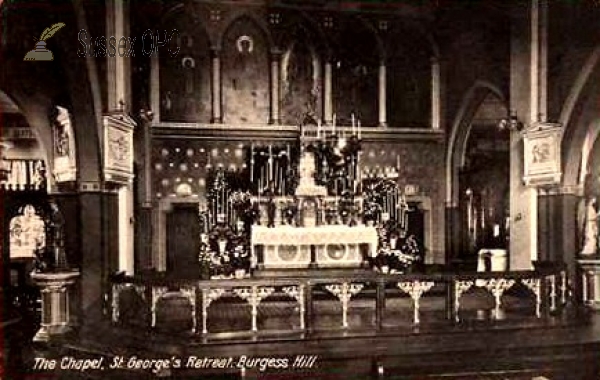
The building a chapel was something that was important in Gill’s mind from the earliest days. His first conception was to built one on top of the Spoil Bank and he went as far as making a drawing of his idea. However this notion was soon abandoned as impractical and attention switched to a site to the South of the workshops. Work was carried out over the winter of 1920-21 and Compline was first celebrated in the chapel on 8 March 1921 with the first mass been celebrated Thursday 8th March. Gill then started work on his own major contribution, the rood cross that hung on the rafter in front of the altar. This was finished in time for the Good Friday office on 6 April 1921.
The style of the chapel would have been a surprise to many Catholics at the time, most churches favouring the ornate over the plain. To some extent the relative plainness of the chapel reflects the religious background of Gill (Low-church Anglican) and Pepler (Quaker). It also reflects the monastic ethos of the Guild, a life of simplicity dedicated to work, family and God. In any case, it was not entirely free from ornament, in particular there were decorative Capitals and the Rood Cross of Gill and the carvings of Chute and Cribb.
Susan Falkner, daughter of Hilary Pepler, described the chapel in this way:
How vivid it is to me still – the feel of the place on a cold winter’s morning as we sat in our damp clothes having traipsed over the fields in the rain. Then again, on a brilliant summer morning, our feet would be wet with the dew of the hay meadow. I remember the feel of kneeling on those flat leather hassocks on the rough brick floor and the scrape of the wooden benches as we took our seats again. The men who were tertiaries faced each other across the chapel and the rest of us, the hoi polloi, faced the altar, of course – the design of a very primitive church. It was a simple faith we had, nurtured by the beauty and simplicity of the chapel itself.



The inscription on the Madonna and Child reads BEATA VISCERA M V QUAE PORTAVERUNT AETERNI PATRIA FILIUM ET BEATA UBERA QUAE LACTA VERUNT CHRISTUM DNU. This means ‘Blessed is the womb of the Virgin Mary, that bore the son of the everlasting Father and blessed are the breasts which gave suck to Christ the Lord’ and is taken from the Beata Viscera, a medieval hymn often sung during a Mass celebrated for the Virgin Mary.
The inscription on St Joseph the Worker reads DE QUACUMQUE TRIBULATIONE CLAMAVERINT AD ME EXAUDIAM EOS ER ERO PROTECTOR EORUM SEMPER. This means ‘Whatever troubles they have, cry out to me and I shall answer them and always look after them’ and is taken form the liturgy of the feast of St Joseph the Worker. The initials in the top corners (MJ and JD) stand for Mary and Jesus, Joseph and Dominic.





Note re St George’s Retreat
As the chapel had no attendant priest, Guild members had to travel elsewhere to attend mass on a Sunday and they generally journeyed some two miles to a local convent, St George’s Retreat, home of The Sisters of St. Augustine of the Mercy of Jesus of Burgess Hill. The convent is still there today, at the centre of a series of recently developed retirement villages on a site now known as St George’s Park.
Among the attendees was Valentine KilBride, who continued to serve mass at the chapel up to the 1970’s. The graveyard at the convent includes a memorial to George and Cissie Maxwell’s son Stephen who was killed in Italy in WW2 and the grave of Anthony KilBride, son of Valentine and Cecilia KilBride who died in 1929, aged 20 months.


